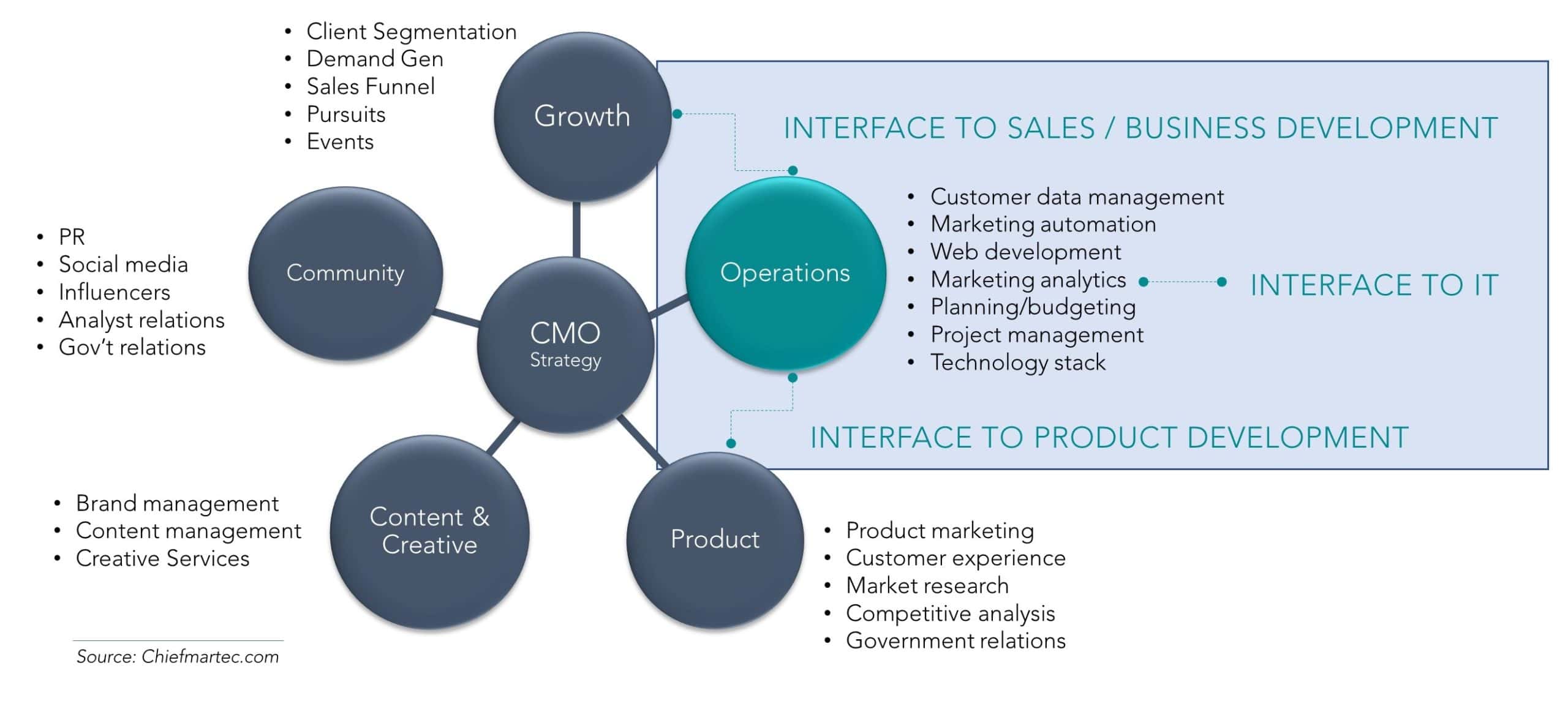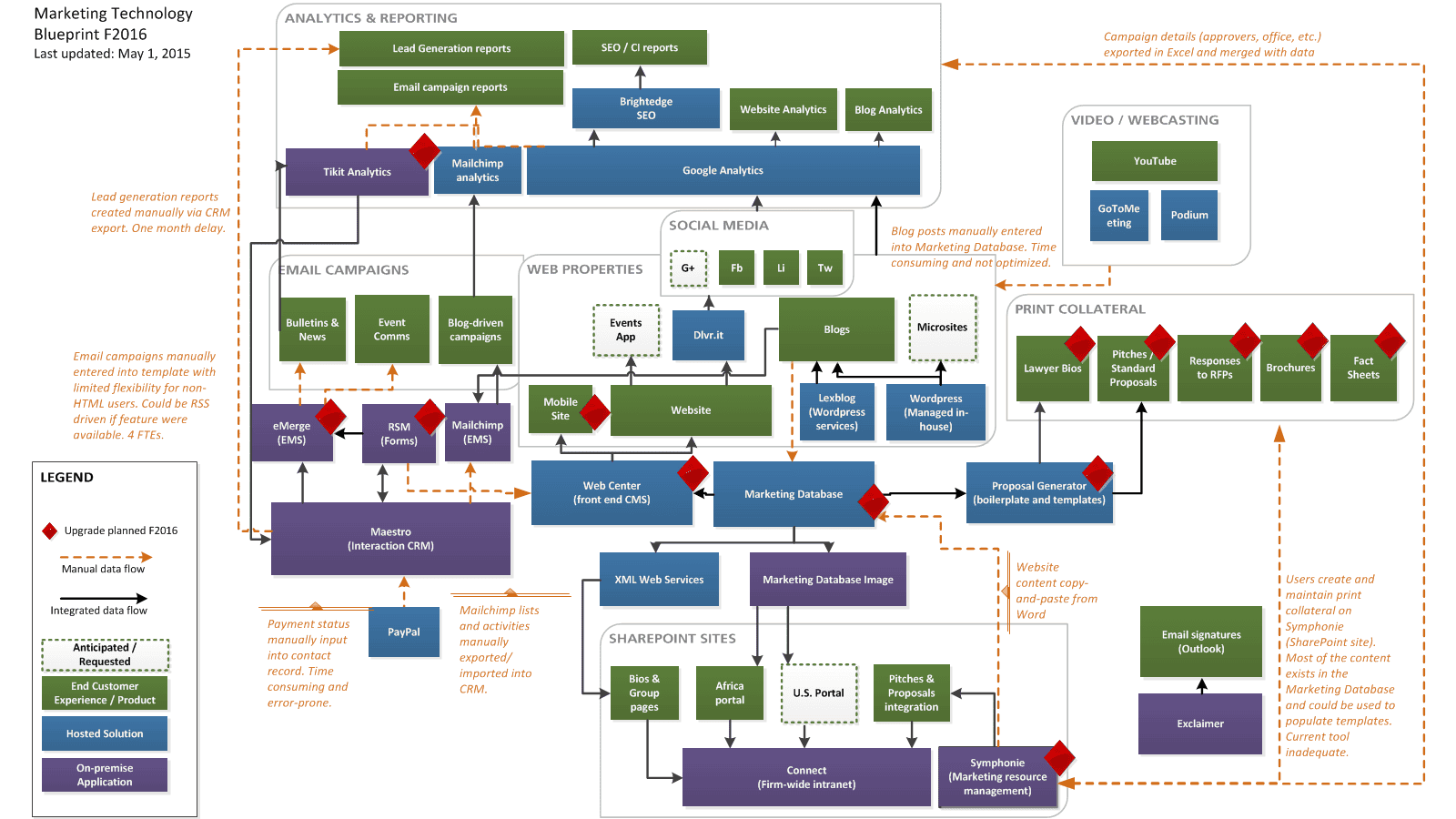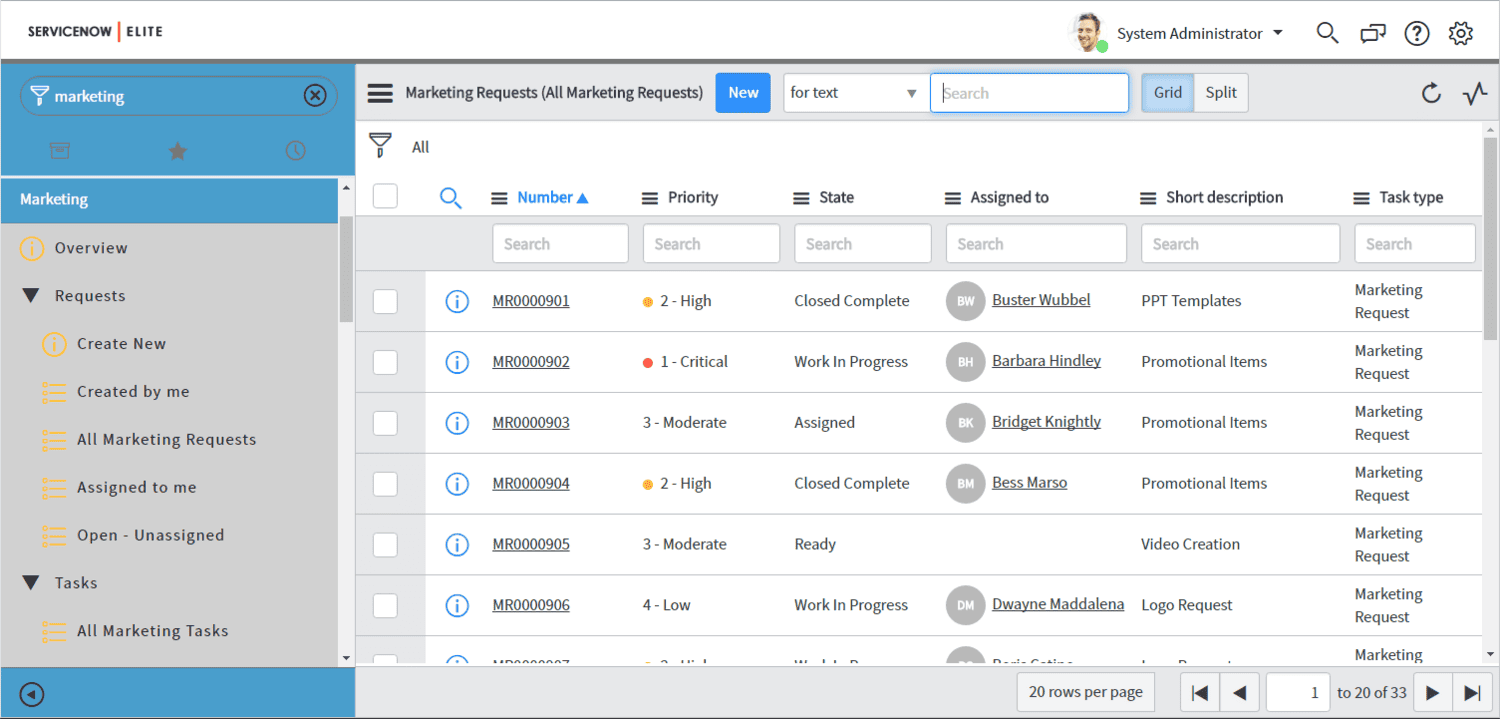In this article, we discuss how Marketing Operations, a rigorous, data-driven approach to managing marketing activity, can help solve many of today’s legal marketing challenges. We also provide some practical insights on how to get started on an operations-driven approach to running a marketing department.
What is Marketing Operations? Here’s a working definition.
The rapidly growing discipline of Marketing Operations seeks to increase marketing efficiency and agility, and to measure, in a continuous and systematic way, how the Marketing/BD function helps businesses grow revenue.
Essentially Marketing Operations uses data to help marketing teams align their operations to help the business grow revenue. It’s about running a marketing team like a profitable business.
Marketing Operations is relatively new in legal marketing. In the broader corporate world, however, it is a mature discipline. The function has become an essential component of the entire marketing team – no longer just a support area.

Responsibilities that used to be buried in other parts of the marketing team have been consolidated under Marketing Ops. And Marketing Ops is also responsible for interface to sales, product development, and the IT organization. In some companies, Marketing Ops drives that entire marketing planning process from start to finish.
Why is Marketing Operations important to law firms?
The legal services market is in the process of transformation due to technology, alternative providers, globalization, changing client demands and other factors. Many law firms are under significant earnings pressure, and this means they are motivated to wring the greatest possible value out of expenditures, including marketing. In these challenging times, an operational approach to marketing can help:
- Demonstrate ROI on marketing to leaders – this is becoming more important than ever as law firm CFOs are challenged to weed out non-productive expenditures.
- Gain efficiency – if you’re like most legal marketers you’re faced with demands to do more with less, and you need to equip team to do that.
- Make better decisions based on data rather than opinion – and we all know there are lots of opinions about marketing in law firms!
- Improve the team’s focus and get off the hamster wheel – help the team address what is most important, and stop spending time on tasks that don’t add value.
The journey to Marketing Operations
The good news here is that there’s lots of opportunity for law firm marketing teams to get more rigorous through an operations-based approach. To get started n the journey to Marketing Operations, you need to be clear on:
- your ultimate goal – whether you’re trying to create marginal efficiencies or effect a complete departmental realignment.
- the resources available to you – especially the marketing data you have today, the systems supporting it, and your expectations for funding.
- your firm’s readiness to explore new ways of doing things – do leaders and partners buy into the need for better ROI on marketing?
- your team’s credibility and ability to deliver – whether you have the right skills today or will need to develop new ones.
Find out where you are spending your time
We believe that the single best way to get started on the journey is a time study – tracking and analyzing the time your team is spending on various types of activities. Doing this for a limited period – say a month – can help to make decisions about where to refocus your team
Once you have time recorded, it’s a simple matter to perform financial analysis against your team’s salaries and other expenses – thereby revealing the true cost of the activities they are performing. You can then identify the tasks that are not contributing to your purpose and which you might stop doing or give away.
Having this information in hand can be a powerful tool when talking to your CFO about changes in structure and activities.
Build your service catalog
An additional benefit of the time study is that it will reveal the various services that your department performs AND how long each service takes to complete. To help you do that we suggest an approach drawn from IT management best practices: creating a Service Catalog to document and publish your team’s specific range of available services.
Typically, a Service Catalog is published on a marketing team’s intranet site. Depending on the team, it may include sections for creative services, campaign management, events, go-to-market readiness, communications, pitches/proposals, and research.

Source: ServiceNow
When you drill down under each section you a list of services, each containing a description of standard deliverables, time required for each, associated costs, requirements for getting started, contact information, and so on.
Creating these service descriptions is the most important part of the service catalog process. Ideally, you would create them collaboratively with your internal clients.
Building this catalog is a big job, but ultimately it sets your team up for success because it removes ambiguity about what you can and cannot deliver.
Establish metrics and KPIs
Once you have settled on your most important activities through your service catalog, it’s time to figure out how to measure them.
To get started, the first thing you need to do is establish what you’re going to measure, and how you will do it. This requires you to have Key Performance Indicators, or KPIs, for the activities you are going to measure.
KPIs are simply the metrics that are most important to the business of your firm – the metrics that matter. Generally, KPIs include targets for acceptable performance that tell you where action is needed.
For example, if part of your core mandate is CRM data maintenance, you might have a KPI for the average time that contacts have not been updated – because out of date contacts reduce the effectiveness of marketing. If the average time increases beyond a pre-determined number of months, you know you need to act, and you know which contacts to act on.
Once you’ve set your KPIs, it’s time to think about how to display them in a dashboard – and show trends over time. There are many ways to do this, from basic Excel tools to highly sophisticated dashboard platforms.
Getting started with martech
Marketing technology is a very large topic area. We have two suggestions for getting started.
First: make friends with your CIO. You need their help – and they need yours. In the past, IT and Marketing have often been antagonists and competitors for resources, but that is changing as marketing becomes more technology driven, and technology is expected to add more value. Strive for a partnership.
Second: get help to document your marketing technology stack. Our research demonstrates that a typical law firm has implemented approximately 17 separate technologies to support marketing/BD, and CMOs report that less than 20% of those technologies are integrated, virtually blocking the connection of meaningful and relevant data points.
This lack of integration among a department’s various tools is the #1 technical challenge facing law firm CMOs today and it inhibits their ability to demonstrate the return on their marketing time and dollars.

Martech Stack for a Canadian law firm. Source: Chiefmartec.com
A good martech stack assessment will:
- Identify and assess the suite of technology platforms used to support your firm’s marketing and business development efforts
- Identify integrations and data flows (both manual and automated) among the platforms
- Document how these platforms are used by marketers, business developers and attorneys, including any perceived issues
- Produce a high-level analysis of gaps and opportunities for improvement in the stack, including prioritized best-practice recommendations and preliminary cost estimates.
Marketing requests and workflow
One marketing operations technology you should consider is a workflow system – a Single Window for handling requests for marketing services.
We’ve found that many professional services marketing teams founder because they’re handling work requests in an unsystematic way. They have no way of prioritizing requests and can’t provide transparency to their clients about status and timing, The result: lots of crazy.
In a well-functioning Single Window system, the internal client has their own portal for making requests and tracking their progress.
The portal provides a menu of the specialist services available – built off your Service Catalog — and realistic time estimates for performing those services.

Source: ServiceNow
The client can request one service – or configure a complex project request with a bundle of services. They can view the progress of all their requests in real time.
Meanwhile, the internal marketing specialists use the same portal to manage their work. Using it, a team can visualize how its individual deliverables fit together to create what the client needs. Specialists can keep track of deadlines and approvals. and understand dependencies on other teams working on the project. They can prioritize work according to the capacity they have available.
Best of all, you get data from the system that can help you in showing how your time was spent, and in allocating resources to high-priority projects.

Connect With Us
If you are interested in learning more about how Calibrate can help optimize your firm’s marketing operations, let’s connect! We’d love to partner with you.






